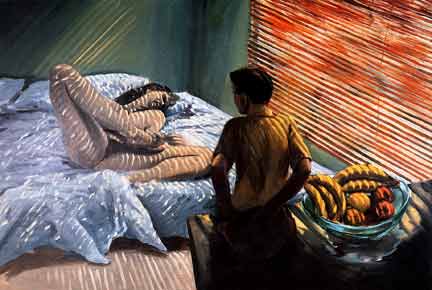On 5 Sep, 2010 With
Maximalism Maximalism is a term used in the arts, including literature, visual art, music, and multimedia. It is used to explain a movement or trend by encompassing all factors under a multi-purpose umbrella term like expressionism. The term maximalism is sometimes associated with post-modern novels, such as by David Foster Wallace and Thomas Pynchon, where digression, reference, and elaboration of detail occupy a great fraction of the text. This sort of literature is also frequently described as hysterical realism, a term coined by James Wood, who argues that it is a genre similar to magical realism. Novelist John Barth defines literary maximalism through the medieval Roman Catholic Church’s opposition between, “two…roads to grace:” the via negativa of the monk?s cell and the hermit?s cave, and the via affirmativa of immersion in human…
Read More
On 4 Sep, 2010 With
New European Painting emerged in the 1980s and has clearly reached a critical point of major distinction and influence in the 1990s with painters like Gerhard Richter andBracha Ettinger whose paintings have established and continue to create a new dialogue between the historical archive, American Abstraction and figurality, followed by painters like Luc Tuymans, Marlene Dumas and others. A third wave came with artists like Neo Rauch, Michaël Borremans and Chris Ofili. Bad boy, oil on linen, 66 inches x 96 inches by Eric Fischl Neo-expressionism and other related movements in painting have emerged in the final two decades of the 20th century in Europe and in the United States, but this New Painting is not expressionist. Rather it is a renovative kind of abstraction and…
Read More
On 2 Sep, 2010 With
Superflat is a postmodern art movement, founded by the artist Takashi Murakami, which is influenced by manga and anime. It is also the name of a 2001 art exhibition, curated by Murakami, that toured West Hollywood, Minneapolis and Seattle. Description Superflat is used by Murakami to refer to various flattened forms in Japanese graphic art, animation, pop culture and fine arts, as well as the “shallow emptiness of Japanese consumer culture.” A self-proclaimed art movement, it was a successful piece of niche marketing, a branded art phenomenon designed for Western audiences. In addition to Murakami, artists whose work is considered “Superflat” include Chiho Aoshima, Mahomi Kunikata, Sayuri Michima, Yoshitomo Nara, Tatsuyuki Tanaka, and Aya Takano. In addition, some animators within anime and some mangaka are considered Superflat, especially Koji Morimoto (and much of the output of his…
Read More
On 1 Sep, 2010 With
Virtual art (in terms of media art) is art practice using virtual reality, augmented reality or mixed reality as a medium. It can be considered a post-convergent art form, containing all previous media as subsets. Notable artists producing virtual art: Maurice Benayoun Brody Condon Char Davies Michael Naimark Myron Krueger Stefan Roloff Jeffrey Shaw Peter Weibel Source: en.wikipedia.org.com
Read More
On 31 Aug, 2010 With
Superstroke is a term used for an post modern art movement with its origins in South Africa. Superstroke is one of the influential art movements regarding African modernism and abstraction. The word “Superstroke” implies the super expressive brush stroke. The Superstroke art movement was initially founded as a reaction to the impact that the Superflat art movement, founded by Takashi Murakami had on modern contemporary art. Manifesto The manifesto for the Superstroke art movement was written in 2008 by the South African artist Conrad Bo and deals with various forms of how paintings in the movement should be executed. This includes the statement that paintings should be created by using very expressive brush strokes. The manifesto also deals with photography…
Read More


